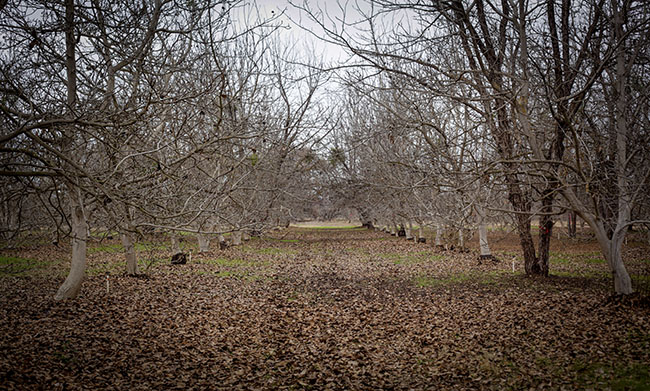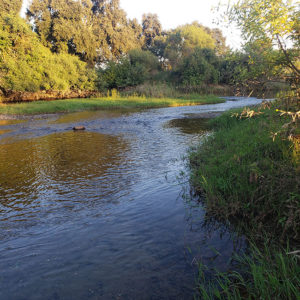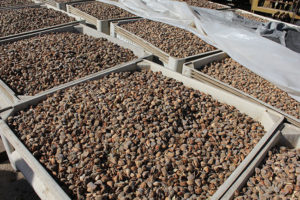
Winter 2022
Riverdance Farms
Like most small-to-medium farms across the country, Riverdance Farms in Livingston, California, had to navigate the changed farm business landscape in this pandemic era. Consumer demands have undoubtedly changed, some markets have altogether disappeared while new ones are gaining traction, but Cindy Lashbrook and husband Bill Thompson, co-owners of Riverdance Farms, have flowed with the changes, adjusting their farm’s marketing and operations as they see necessary.
Everything grown at Riverdance is organic and has been since the 1990s, when the farm was purchased. The couple added to it with the adjacent property in the early 2000s. Sixty of the 74 acres are actively farmable, with, as Lashbrook said, the remaining acres belonging to the river.
The farm features an assortment of designated fruit and vegetable acres, in addition to Independence almonds, Chandler walnuts and Wichita pecans. Since the land has varying topography in California’s rather flat Central Valley, and varying soil types, Lashbrook has customized her plantings according to where they would grow best, as well as what pick-your-own enthusiasts enjoy.
Back on track
Like for many farmers, 2020 was a year of pauses or setbacks, with nut buyers unable to make payments, prices dropping in other commodities and community-supported agriculture programs going out of business after deliveries were made. Riverdance Farms had to absorb these costs.
“We had a lot of dings – a few thousand here, a few thousand there – that we were expecting to come in and they just evaporated,” Lashbrook said. “It’s not just because of COVID, but also trade agreements and other companies’ marketing efforts during COVID.”
But 2021 was a year to steer things back on track. Riverdance is in its second year with new nut buyers. U-pick has remained popular, and the farm’s annual Pick & Gather Festival was stretched over three weekends instead of one, and will build on this format in 2022.
In addition to working with the National Resources Conservation Service Environmental Quality Incentives Program offerings to plant cover crops and hedgerows and follow wildlife-friendly practices, Riverdance retired about seven acres from production and restored it to riparian habitat, a wildlife pond and native plants. This season, the farm has been working with American Farmland Trust to apply for a conservation easement through two programs administered by the California Department of Conservation.
“If we are awarded either grant, we will relinquish some of our development rights and protect this land in perpetuity for its agricultural and wildlife values,” Lashbrook said.

The usual battles
Coping and maneuvering around the new industry challenges comes in addition to the usual pest management challenges on an organic farm. With far fewer pest control options than a conventional farm, Riverdance is surrounded by pollinator plants to bring in natural enemies to pests and hosts many insectivorous birds.
“We have a (natural) crew to work with, so we don’t want to disrupt it too much,” said Lashbrook. “But sometimes it just isn’t enough.”
2020 saw a slight uptick in worm damage in the walnuts, but 2021 was an excellent year and the orchard exceptionally clean. With the majority of the
Central Valley being planted with tree nuts, Lashbrook acknowledges that the surrounding conventionally grown orchards bring her more problems as she becomes less and less island-like with her crop.
“We have to monitor more now,” said Lashbrook.
By monitoring for walnut husk fly this year, the orchards required only one well-timed, organic-approved insecticide spray, and walnut production was up two times over the previous year.

After another year battling the imported red fire ant, a new product option is next on the list for strategizing a control method. Though Riverdance has never used out-of-state bees for pollination, the ants made an appearance after the county began placing traps.
“Ten years or so ago, (the county) first started monitoring for it and leaving stuff around, so they might have accidentally brought (the imported red fire ant) with them. And the ants are happy to be in our fairly sandy soil without much disruption, so that’s something that’s difficult to manage with biocontrol,” said Lashbrook.
A few different options have been deployed on the farm to varying degrees of success, including boiling water, diatomaceous earth, baits, spinosads and others. Lashbrook continues to research additional organic-friendly options, with a d-Limonene-based product next on her list.
The year ahead
Every year, Riverdance hosts the family-friendly Annual Pick & Gather Festival, where visitors can pick organic produce, camp, fish, participate in crafts and games, geocaching, kids’ science classes, food preservation classes and more. The event usually brings in over 1,200 visitors and Lashbrook will expand the event over three weekends in 2022. U-pick reservations are also available.
First introduced as a solution during 2020 lockdowns, the reservation system proved a smart choice. Riverdance has been able to serve the needs of people wanting better quality food and to explore safe outdoor areas. Because of this, Lashbrook is making Riverdance’s offerings increasingly more diverse, including more stone fruit to stretch the U-pick season and adding a pizza garden.
“This way, there’s almost always something to pick,” she said.
The farm is currently marketing its fall fruits and nuts, will be fully utilizing Barn2Door before the season is over and will be ready with programs for the spring fruit. It will also continue to market some of the almonds, walnuts and all of the pecans in the spring. Lashbrook is also considering forming a farm membership where members can visit the farm and participate in a variety of activities, including pick food, picnic, garden and camp.
“I love people who love to be here; it makes me happy. If I can find more ways to have people come pick their own or pick up their own, and possibly even have a community garden plot of their own, we might work something like that out,” said Lashbrook.
Photo: This season was a great year for the farm’s walnuts with production up and pest pressure low. Photos: Crystal Nay







